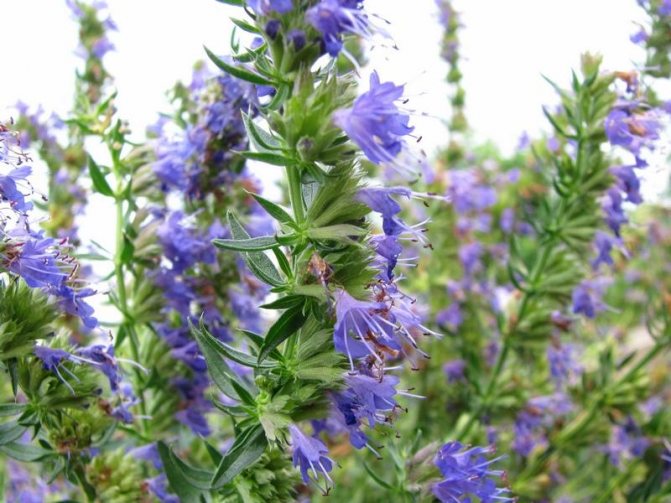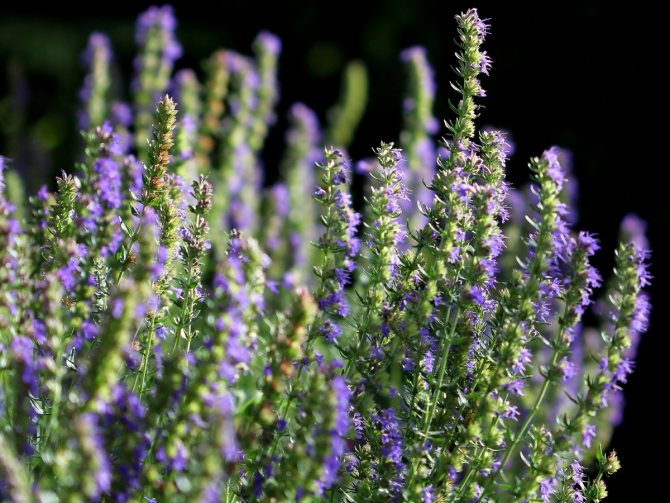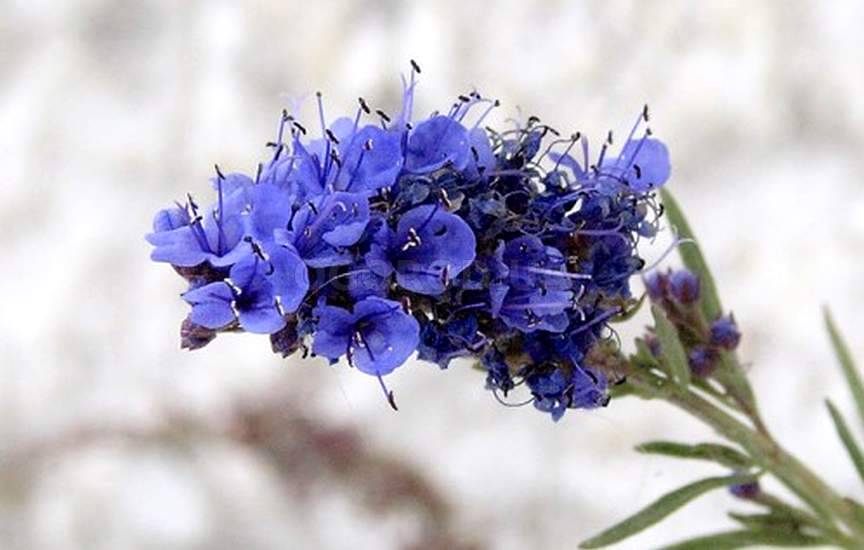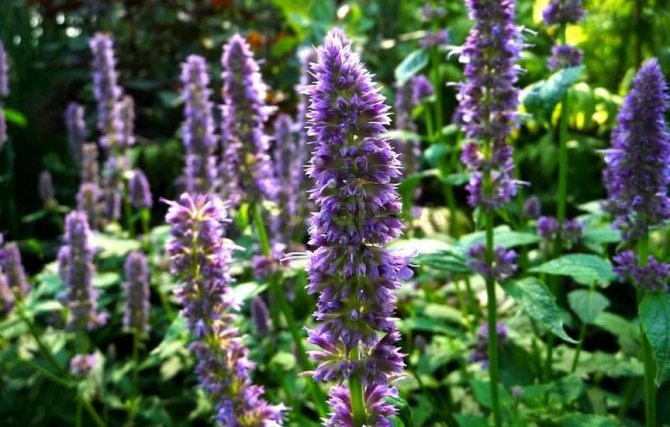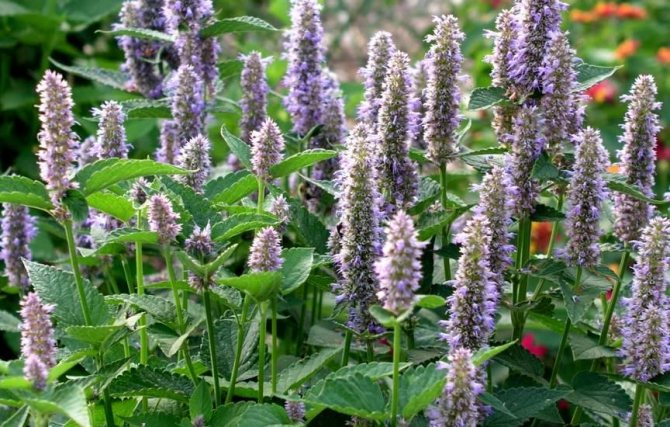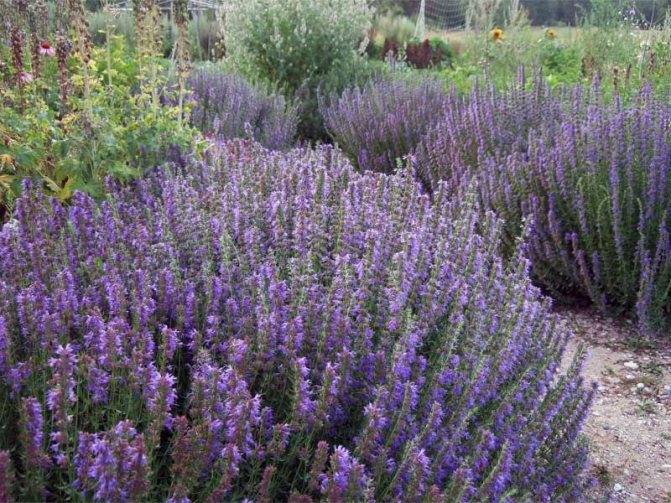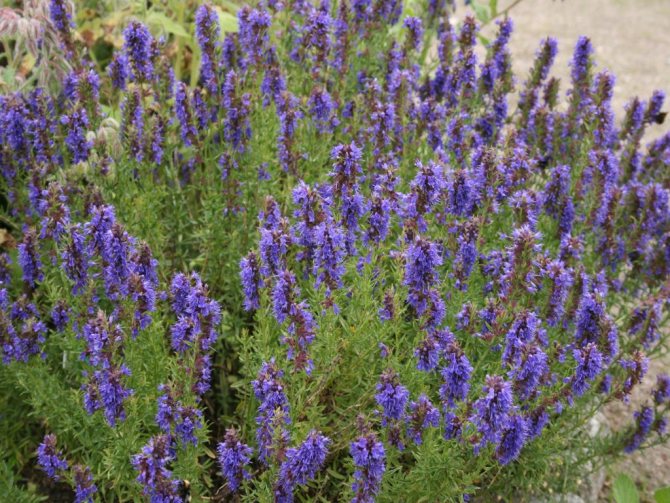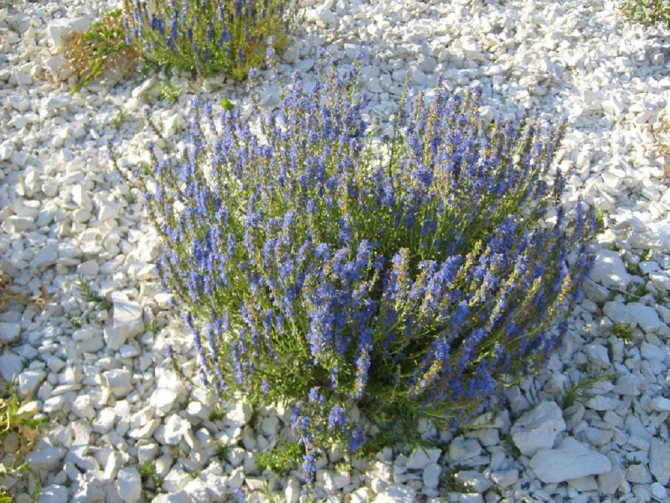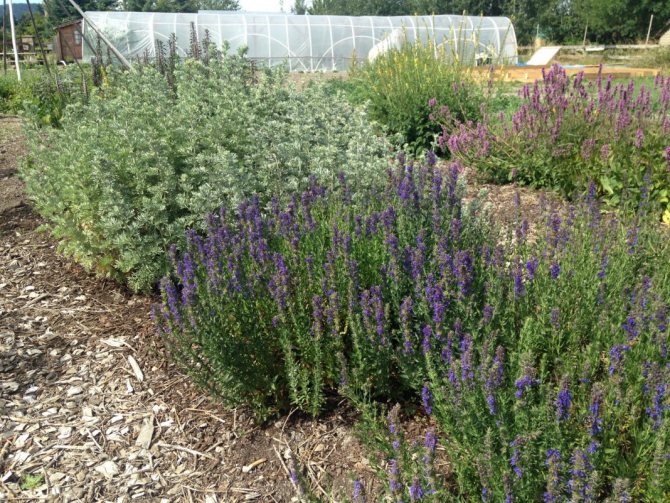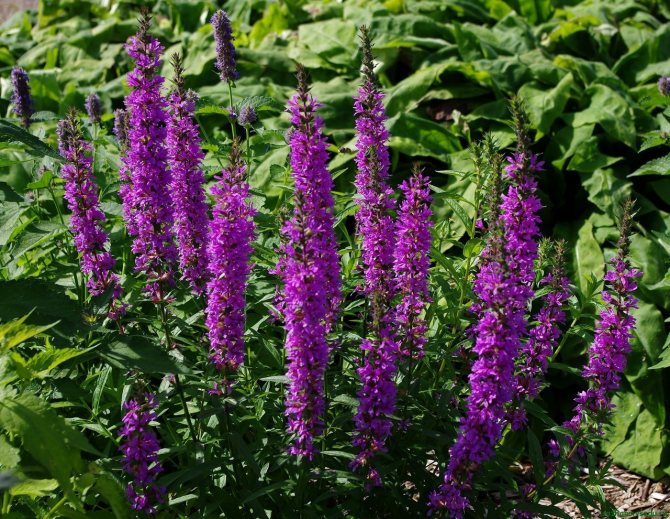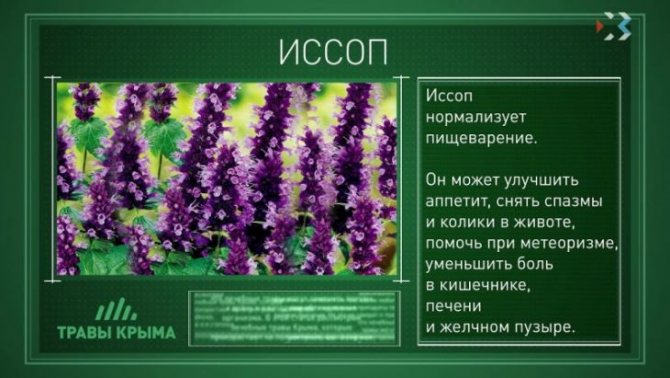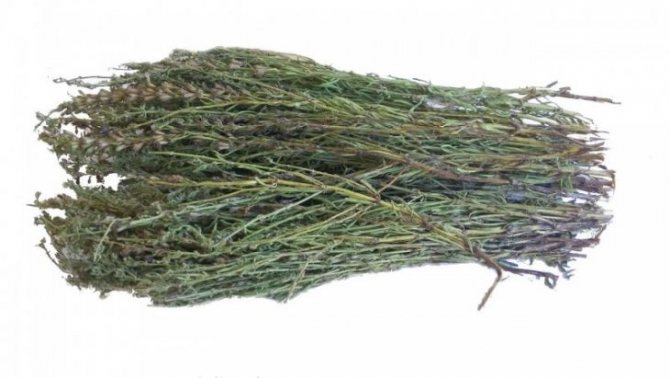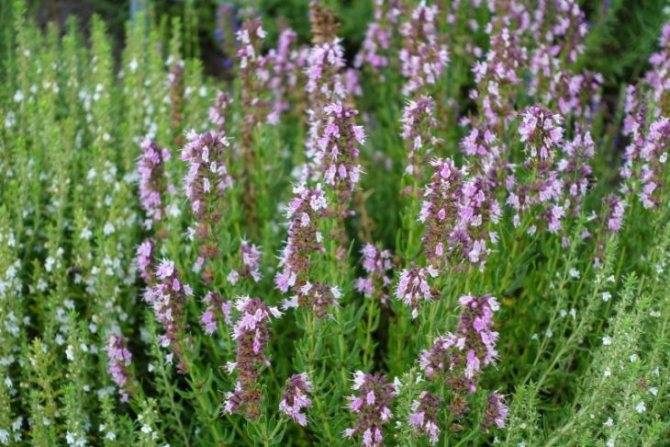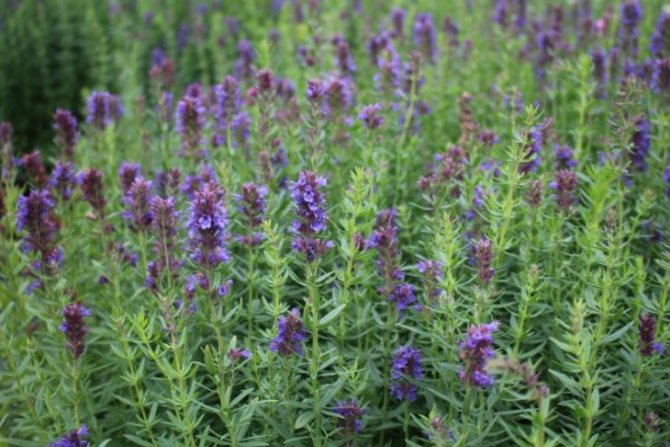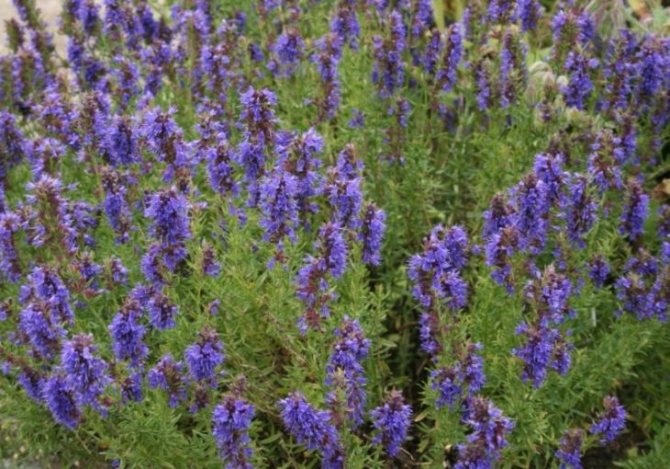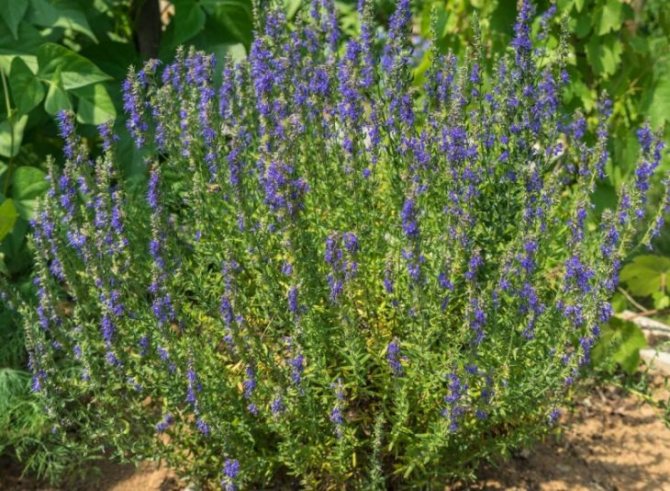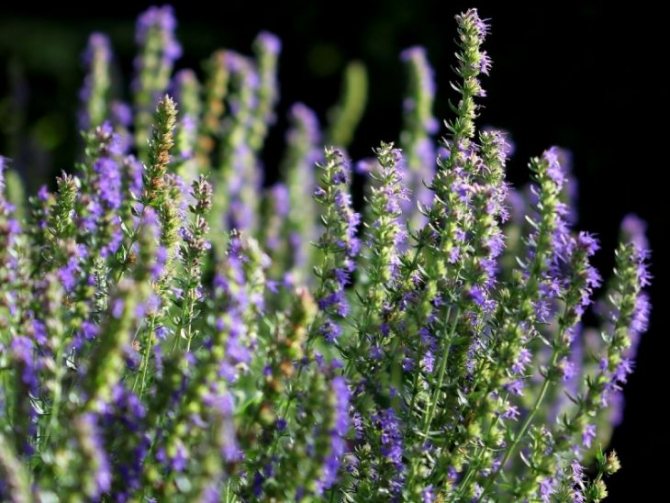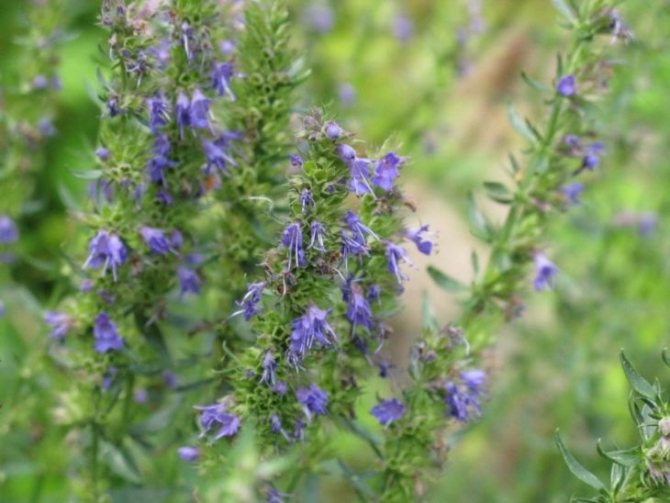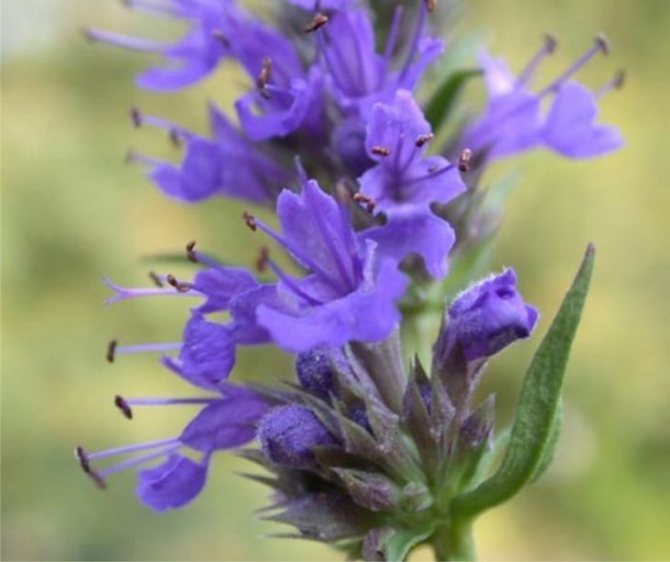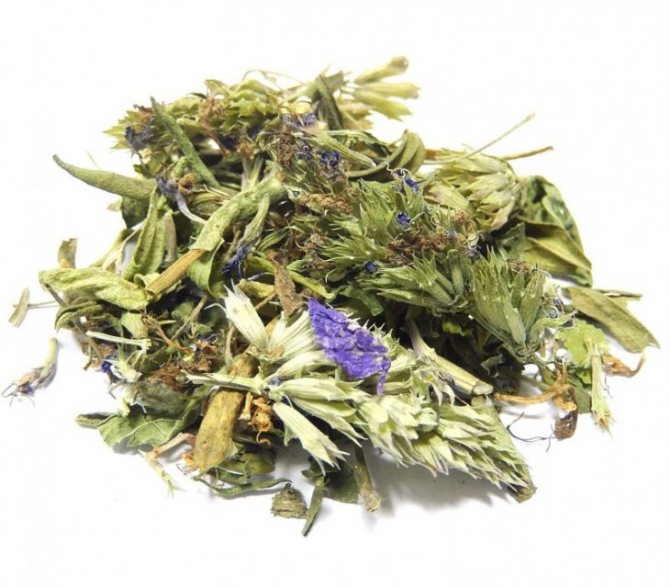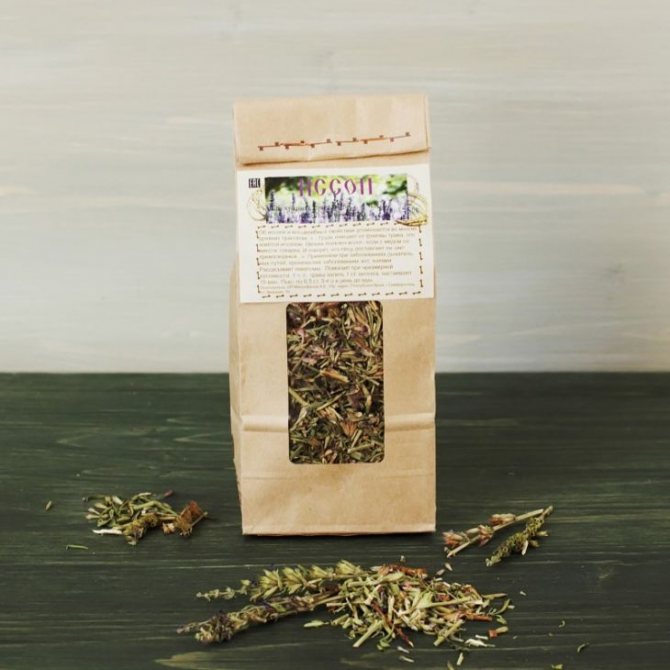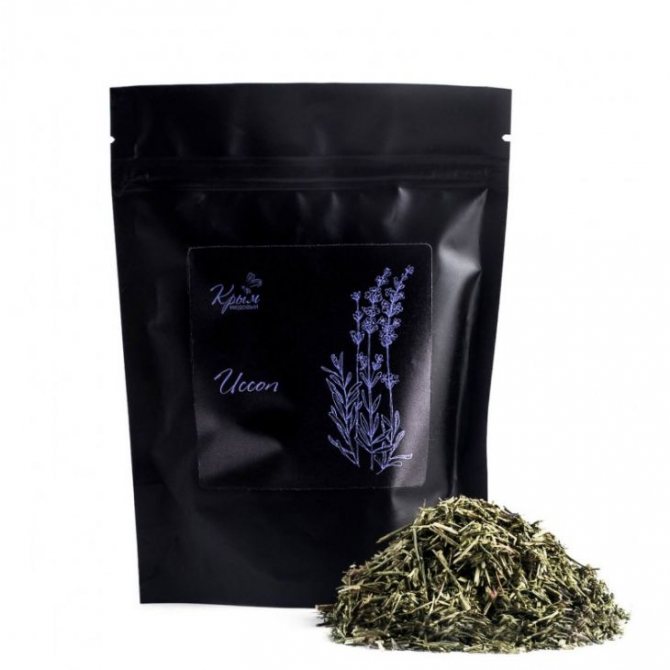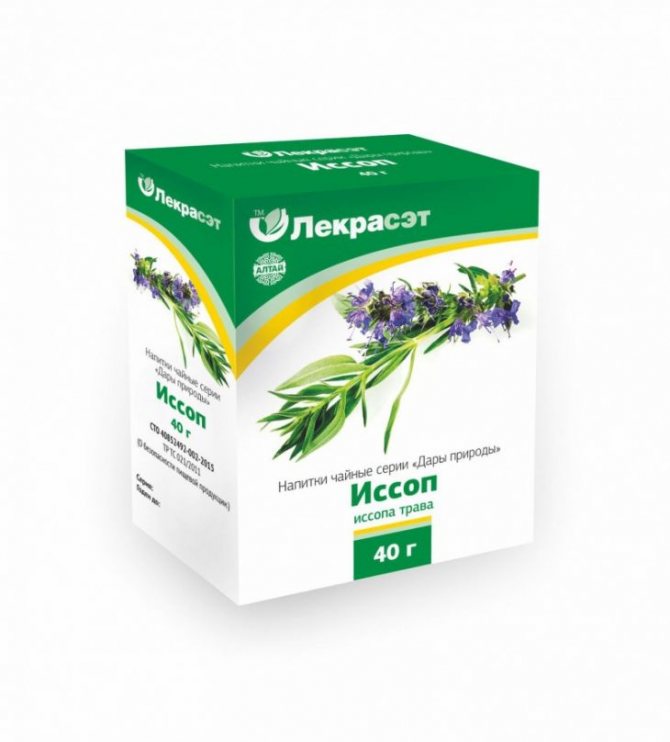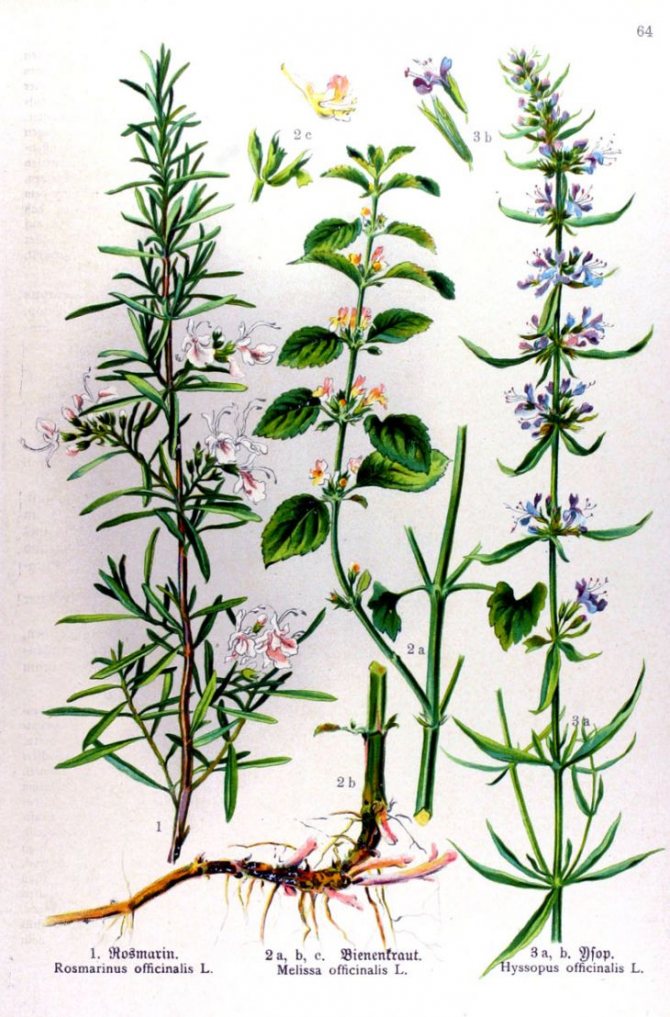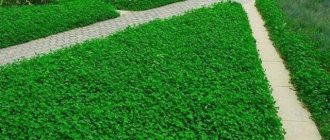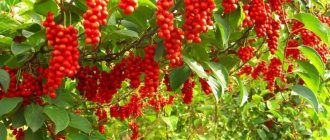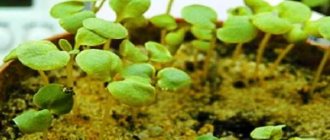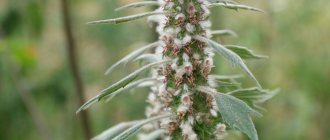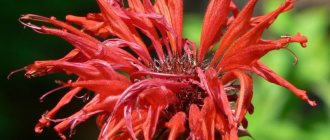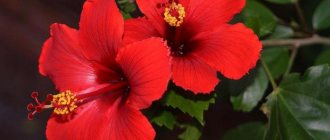Category: Garden plants
Plant medicinal hyssop (Latin Hyssopus officinalis), or common hyssop, or blue St. John's wort - a species of the genus Hyssop of the family Lamiaceae, a dwarf shrub that grows wild in North Africa, Western Asia, Central, Southern and Eastern Europe. In culture, hyssop is grown in North America and almost throughout Europe. The herb hyssop is the oldest medicinal plant, which was used to treat patients by Hippocrates and Dioscorides. Young shoots of hyssop with leaves, fresh and dried, are used as a spicy seasoning for appetizers, first and second courses. Hyssop is also included in diet meals.
At the very beginning of the 14th century, the famous physician Arnold from Villanova wrote the poem "Salermo Code of Health", dedicated to medicinal plants. About the hyssop, it contains the following lines:
“The herb, which is called hyssop, cleanses the chest of phlegm. Hyssop is useful for the lungs, if it is boiled together with honey, And they say that it gives the person an excellent color. "
Types and varieties
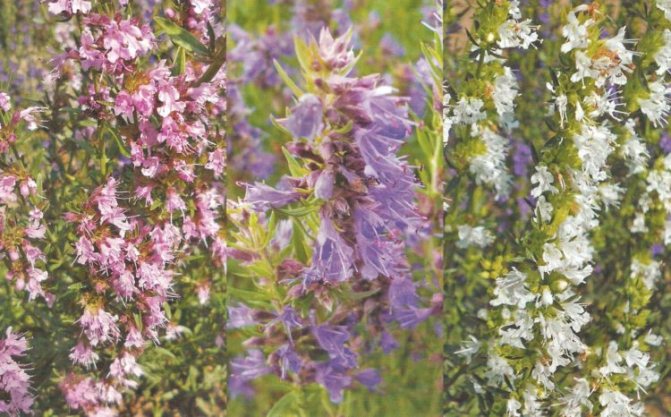
According to the modern classification, the hyssop herb is considered as seven species of representatives of the Lamiaceae family, growing on the Eurasian and African continents. In our latitudes, hyssop is found in only three types:
- I. medicinal, growing as a shrub and reaching a height of 80 cm;
- I. chalk, no more than 60 cm high, growing on chalk deposits, which is on the verge of extinction. It is listed in the Red Book of Nature.
- I. dubious (ordinary), a low plant, barely reaching 40 cm in height, but containing a huge amount of essential oils in its composition, for which it is appreciated by modern culinary experts.
In recent years, breeders have bred several varieties of decorative and not only blue St. John's wort with beautiful bright and light flower panicles, which are successfully used in landscape design, since representatives of this group of plants are very unpretentious to growing conditions.
Useful and medicinal properties of medicinal hyssop
Hyssop contains a huge amount of valuable substances, which determine the spectrum of its pharmacological activity. Research by biochemists has shown that hyssop has the following properties:
- expectorant;
- antimicrobial;
- antioxidant;
- diuretic;
- pain reliever;
- sedative.
Useful properties of hyssop
Herbalists deservedly call hyssop as well as St. John's wort - a cure for a hundred diseases.
- The most widespread use of the medicinal properties of hyssop was obtained in the treatment of colds;
- Herbalists advise using it to directly treat colds, bronchitis, tracheitis, laryngitis and hoarseness in the voice;
- The herb is used as an excellent antipyretic, expectorant, tonic and antiseptic. The plant promotes soft sputum discharge, helps to cope with sore throat, prevents stagnation of secretions in the lungs. For older people who often have a dry throat problem, the remedies will also help very effectively;
- Helps hyssop with stomatitis or other diseases of the oral cavity;
- The antiviral effect of the herb provides tangible help in conjunctivitis;
- Normalizes digestion, improves appetite. Helps with intestinal catarrh, chronic constipation, dyspepsia, flatulence and chronic colitis.And not only removes all symptoms, but also promotes complete recovery;
- Actively combats bad breath;
- If you have no contraindications to the use of hyssop, then use remedies from it to treat ailments of the heart and blood vessels, angina pectoris, anemia, rheumatism, increased sweating;
- In addition, the medicinal plant is an excellent biostimulant. Your memory will improve significantly, it will be much easier to focus your attention if you just drink tea brewed with the plant;
- Hyssop gently relieves the manifestations of depression, while not causing drowsiness - this is its undoubted advantage;
- The diuretic action of blue St. John's wort will rid you of the fine sand in your kidneys;
- The herb is a natural natural anthelmintic agent, often used in folk medicine to expel helminths.
It is used in traditional medicine to treat a large number of diseases:
| Diseases and conditions in the treatment of which hyssop is most effective as an independent remedy | Diseases and conditions in which hyssop is used as an auxiliary herbal remedy, as part of a complex collection |
|
|
Appearance


The description of the appearance of the main representatives of this genus is very similar, despite the difference in height. All of them have a well-developed rhizome, thick pubescent stems with densely planted leaves. The flower is not very large, mostly blue, but there are also bright purple or pale blue inflorescences, collected in a panicle. Fruits - seeds, resemble naked nuts in shape, up to 2 mm long and no more than 1 mm wide. Blooms from mid-June to late August.
Chemical composition
Medicinal hyssop is an essential oil plant. Its main value lies in essential oil, the content of which ranges from 0.6 to 2%.
Along with this, other biologically active compounds were found in the composition of hyssop:
| Substances | Content in hyssop (mg per 100 g of raw material) |
| Essential Oil Components | |
| Terpineol | 1,7 |
| Limonen | 0,2 |
| Linalool | 39 |
| Linalyl acetate | 2,4 |
| Cineol | 2,7 |
| Terpenyl acetate | 3,3 |
| Thymol | 1,5 |
| Bornyl acetate | 0,7 |
| Pinocampon | 6,1 |
| Isopinocamphone | 0,9 |
| Minerals | |
| Potassium | 1-1,2 |
| Calcium | 1-1,1 |
| Magnesium | 1 |
| Silicon | 0,35 |
| Aluminum | 0,12 |
| Other substances | |
| Organic acids | 5,1 |
| Free amino acids | 14,2 |
| Associated amino acids | 45,3 |
| Flavonoids | 0,6 |
| Glucose | 13,5 |
| Galactose | 10,9 |
| Pectin substances | 14 |
| Tannins | 18 |
How does hyssop herb help in a healthy and healthy diet?
Hyssop medicinal (pictured) is considered a weakly poisonous plant, therefore, its use is possible only for therapeutic purposes in a limited dosage, but not as a main dish on the menu.
During a diet for weight loss, hyssop can be treated - it can in no way harm either health in general or the figure in particular. On the contrary, it stimulates metabolism and digestive activity to a mild extent.
What can be combined with hyssop
In traditional medicine recipes, there are such effective combinations of hyssop:
- with licorice and honey - as an antitussive agent;
- with calendula - for rinsing the mouth with stomatitis, gingivitis and sore throat;
- with parsley seeds, chamomile, horsetail and St. John's wort - with cystitis;
- with raspberries - as a diaphoretic.
In cooking Hyssop is not used very often, but experts say that it is able to give dishes a unique aroma and piquant taste. It is recommended to add dry chopped hyssop
- to meat (veal, pork, chicken, turkey, minced meat and sausage);
- to poultry offal (chicken liver, liver pate);
- in soups (with legumes or meat);
- in sauces in combination with parsley, fennel, marjoram, mint, dill.
Fresh greens of hyssop are used in pickling vegetables (cucumbers and tomatoes), in cottage cheese dishes.
In the food industry Hyssop is an essential ingredient in Chartreuse and sorbet liqueur.
Where and how it grows
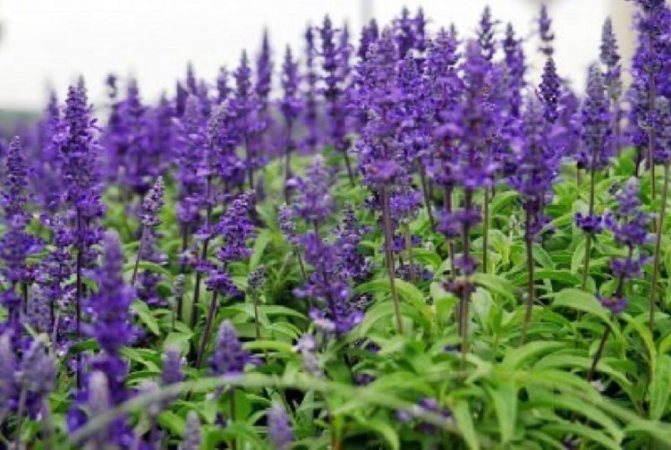

In the wild, you rarely find hyssop, the grass is found almost everywhere only in the Mongolian and Dagestan territories. Naturalization and domestication of hyssop has long been carried out in Europe and the United States. It thrives on well-drained soils.
And if you consider that this herb is an excellent honey plant, it is grown in large volumes by beekeepers. The photo above shows the blooming fields of hyssop.
How to grow hyssop
Hyssop care
Growing hyssop is easy and enjoyable. All you will need to do is water it occasionally, loosen the soil around the bushes, remove weeds at first and apply fertilizer to the soil. Hyssop is watered only in a prolonged drought, spending 15-20 liters of water per square meter of land, but usually the plant looks fresh even in strong dryness, and natural precipitation is quite enough for it.
- Fennel: growing from seeds, beneficial properties
If it seems to you that the hyssop is growing slowly, feed it with a solution of complex mineral fertilizer at the rate of 20-30 g per 10 liters of water, although it is better to use organic fertilizing. If the plant does not bloom well, this means that the soil is oversaturated with fertilizers, and the hyssop does not like this.
Formative pruning of hyssop is usually combined with the preparation of medicinal raw materials. The plant tolerates the haircut easily and grows back quickly after it. The plant hibernates without shelter. In autumn, hyssop shoots are cut at a height of 10-15 cm. This is done in order to stimulate abundant flowering and the formation of a dense bush in the next growing season.
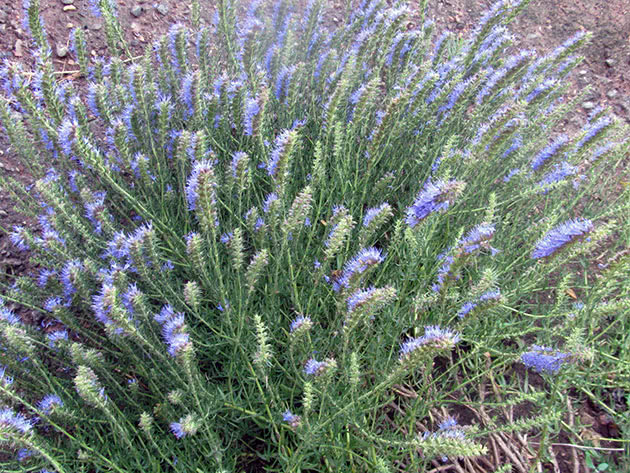

If you grow hyssop as a medicinal raw material, try to avoid self-seeding, as this weakens the medicinal properties of the plant. To avoid self-seeding, you need to carry out regular weeding and cut the bush before the seeds ripen.
Although hyssop can live in one place for a decade, after 4 years it begins to bloom worse, so you should rejuvenate the plant by cuttings or dig up, divide and transplant the hyssop bushes to a new place.
Hyssop pests and diseases
Hyssop is extremely resistant to diseases and pests, but sometimes it can be attacked by rust, rhizoctonia, fusarium wilting, or white spot. You can destroy pathogens by treating hyssop with fungicides, but if you follow the rotation of crops and the rules of plant care, the hyssop is unlikely to get sick. Do not forget to remove plant residues from the site after the autumn pruning.
As for pests, the smell of hyssop scares them away not only from the area with the plant, but also from the crops growing in the vicinity of the hyssop.
What to plant after hyssop
After the hyssop, you can plant beans, peas, potatoes, tomatoes, onions, and garlic.
- Growing cabbage seedlings in 2019: when to plant
Benefits and Applications


It is impossible not to pay attention to the useful, truly unique properties of this plant. Freely growing throughout our country, hyssop has excellent phytoncidal properties, due to the sheer amount of essential oils in the plant sap of leaves and flowers.
In cooking
The flavoring plant is very popular with culinary experts for its delicate aniseed taste.From the dried inflorescences, a rather piquant seasoning is obtained, which is very popular, because it turns out to be multi-colored - pink, white, blue, deep blue or bright purple. It depends on the color of the flower.
In medicine
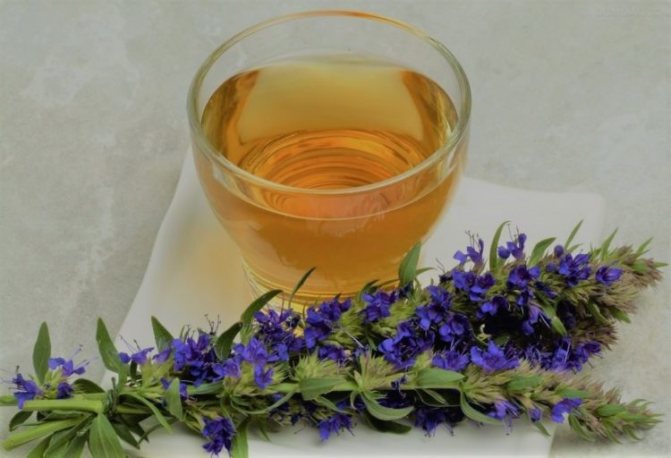

Since ancient times, medicinal hyssop has been used to treat many diseases; the use of the herb is associated with its unique composition. St. John's wort contains both triterpenic acids and bitter substances, as well as a huge amount of ascorbic acid. It exhibits medicinal properties for relieving the symptoms of a number of diseases:
- Respiratory organs - bronchial asthma, bronchitis, laryngitis, pharyngitis.
- Diseases of the digestive tract - with colitis, enterocolitis, gastritis, flatulence.
- Nervous system - neurosis, excessive sweating, sleep disturbances.
- For women, tincture of the herb is prescribed for menopause.
- In dentistry, you rinse your mouth with a decoction of herbs for stomatitis.
- Externally, decoctions of hyssop are used for disinfection and rapid healing of wounds, ulcers, as well as for washing the eyes in case of a viral infection.
In cosmetology
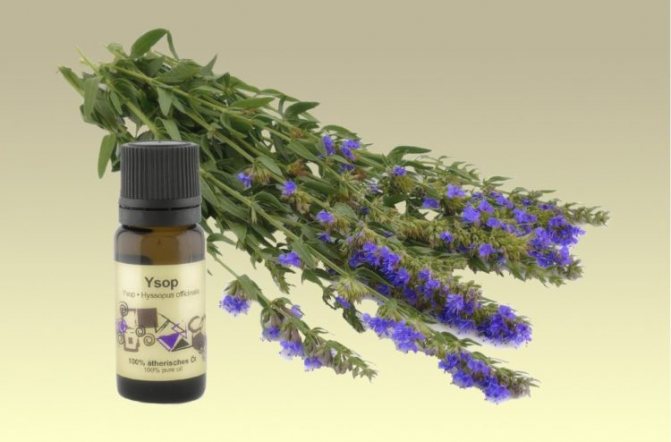

Due to the content of gum, aldehydes, hydrocarbons and organic alcohols in vegetable juice, it is successfully used for cosmetic purposes. The essential oil has a transparent greenish-yellow color, and has a bright turpentine-camphor aroma due to the content of pinene, camphene and pinecamphiol in its composition.
Did you know? Plants with bright blue flowers contain more essential oils than blooming white, red or pink shrub.
Features of medicinal hyssop
Naturalists identify about 50 varieties of this shrub, but the value for humans is contained in the medicinal hyssop. It grows in Russia almost everywhere, it is also present in certain places on the European continent, in the North African expanses, in the western part of Asia.
The most useful shrub is at the time of flowering. During this period, it contains essential oil, oleic, ascorbic acids, hyssop herb promotes the speedy healing of wounds, increases the immunity of the human body to various diseases. Recently, experts have identified B vitamins in the composition of this plant, which only enhances the undoubted healing qualities of the shrub.
Hyssop also acts as an excellent honey plant. Honey is used to improve appetite, it is an excellent tonic for the stomach, this substance also perfectly helps in cases of diarrhea, flatulence, relieves a person from an annoying, unpleasant cough.
Harm and contraindications
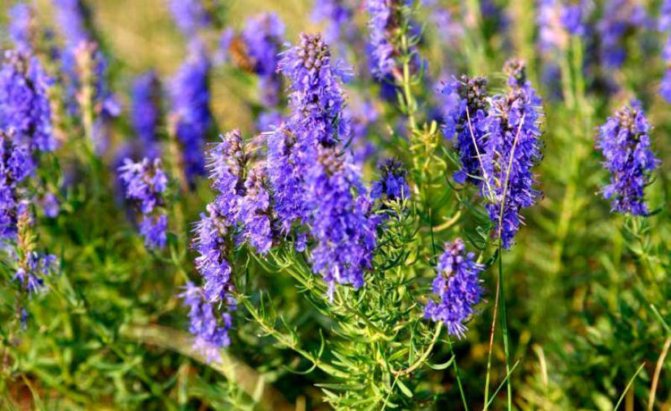

Hyssop should be used with caution, as it is considered a weakly poisonous plant, and all the benefits of using it in an inappropriate dosage or for a longer period than prescribed by the doctor may come to naught.
There are a number of people for whom the use of blue St. John's wort is contraindicated:
- epileptics;
- children under 12 years of age;
- patients with acute renal failure;
- with hypertension;
- people with high acidity;
- pregnant women and women during lactation.
Cooking applications
Hyssop has a mint-anise flavor, reminiscent of some cough syrup. This spice is strong enough to overwhelm all other ingredients. Add the hyssop a little at a time to avoid ruining your food or drink.
The flowers have a subtler taste and softer aroma than the leaves. If you don't want its flavor to dominate the dish, use flowers as a seasoning.
The dried leaves of this plant are often included in spice mixtures.
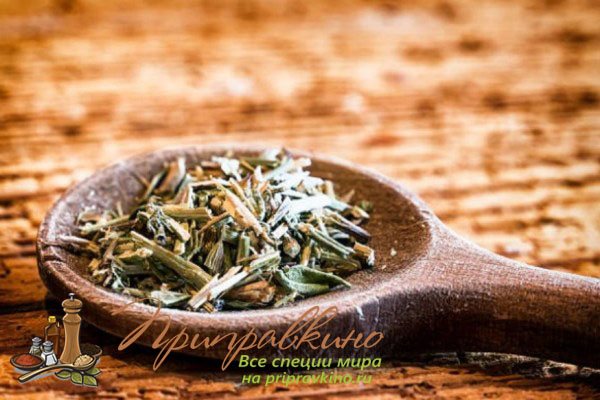

In the form of oil
Combine chopped fresh hyssop leaves with softened butter. Freeze in small portions (you can use ice cube trays). This will create a fragrant herbal oil that can be used for stewing meats and vegetables.
Where and when to add
Due to its intense taste, it is used with products that have strong specific aromas. For example, hyssop perfectly complements venison and lamb.
- It goes well with fatty meats. Fresh hyssop can be used to grate the crust of a toasted steak. Dry chopped leaves are mixed with other seasonings and sprinkled on the meat before frying.
- The mint notes in the scent make the hyssop a wonderful condiment for sweets. Use it to flavor syrups, jams and candies, and in cakes and other baked goods.
- Another popular culinary use of hyssop leaves is to add one or two leaves to tea or lemonade.
The herb's ability to withstand long cooking times is what determines when to add it to a dish. Hyssop is placed at the very beginning. In most cases, you won't have to worry about losing flavor, even if the dish has been cooking for many hours.
Dried hyssop
Dried hyssop leaves can be hard and brittle, like fish bones. If they come across in a cooked dish, they will not be easy to chew. This is easily circumvented by using a seasoning like Garni's bouquet:
- Fold the dried hyssop into a gauze bag.
- Place in stewing liquid to transfer the flavors to the dish.
- Remove the pouch before serving.
Tea
Like many plants in the Mint family, hyssop is an excellent tea herb. Dried or fresh leaves and flowers are excellent for making a drink.
How to brew:
- Boil two glasses of water.
- Sprinkle two tablespoons of fresh hyssop leaves in it.
- Insist for 30 minutes.
Hyssop tea is used mainly for medicinal reasons - it helps with various diseases of the respiratory tract. In it, the bitterness often outweighs other notes, so it is recommended to add honey, stevia, or another sweetener.
Only you can decide whether to use hyssop for treatment or focus on its culinary possibilities. Natural does not always mean safe. Be sure to study all its beneficial properties and contraindications, remember what medications and supplements you are already taking.
Growing and care


Like many vegetable crops, the medicinal herb thrives on fertile, well-drained soils. Growing blue St. John's wort is not a problem - the seeds germinate perfectly in a couple of weeks. Seeds are planted directly in the open field, with a row spacing of no more than 0.15 m.
Important! Different varieties are sown at a great distance from each other, since the plant is self-pollinating. This cannot be done in small areas.
But it is not difficult to grow hyssop, planting and care in the open field consists in growing and further transplanting a plant in the presence of 5-6 true leaves on the stem. Hyssop care is also simple. They take care of the perennial medicinal dwarf shrub, regularly watering, weeding and feeding with mineral fertilizers 2-3 times during the growing season.
Hyssop plant - description
The root of the hyssop is ligneous, the stems are branched, tetrahedral, short pubescent or almost glabrous, twig-like, woody at the base, from 45 to 70 cm long.Leaves are almost sessile, opposite, short-petiolate, lanceolate, whole-edged, 2 to 4 cm long and 4 cm wide up to 9 mm. Small double-lipped purple, blue, white or pink flowers, located 3-7 pieces in the axils of the leaves, form an apical spike-shaped inflorescence. Hyssop continues to bloom from June to October. The aroma of the plant attracts bees to the garden: any type of hyssop is a honey plant. Hyssop seeds ripening in the second half of August remain viable for three to four years. With a strong spicy aroma, the plant remains green even after the onset of winter.
- Elderberry: planting and care, pruning and reproduction
Hyssop is a popular culinary spice and versatile medicine.
Procurement and storage
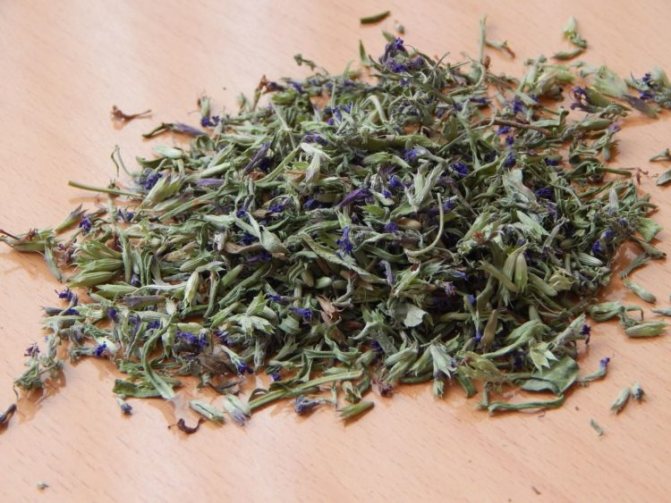

The ground parts of the plant are harvested at the very beginning of flowering, until the stem is stiff. Then the collected parts are dried in the shade. For seasoning, collect the petals of fully blossoming flowers. This is how a bright aroma of seasonings is achieved. When dried, the color of the petals is preserved, and the seasoning can be made multi-colored. Only dry pink, white and blue petals separately.
The shelf life of the dried herb is short; after six months, the dry plant loses all its healing qualities, even if it is hermetically sealed.
Magic
As for the magical properties of this herb, this is one of the main herbs considered anti-demonic - adding to the bag with aromatic herbs for bathing, in bags and incense to protect against evil forces. To protect against dark forces, the herb should be used exclusively in the form of smoking or water infusions. Just dried grass or alcoholic infusions will not help here. The grass prepared in advance must be dried so that, having lost moisture, the grass gains a fiery energy force. The very power that will increase the ability of the grass to drive away not only all kinds of evil spirits, but also bad intentions and evil intentions that penetrate your thoughts. The smoke from smoking cleans not only a person, but also his home.
In the Bible, it is called bitter herbs, and brooms from it were used to anoint jambs during Egyptian executions so that the Angel of Death would pass by and not take the first-born, brooms from it were used during divine services by the Levites, the plant most often mentioned in the Bible after grapes.
If your child is having bad dreams, you can add some weed to the mattress padding or prepare a small bag of this weed and place it under the pillow. The smell of this herb will save a child from being frightened in a dream, and incense prepared from hyssop will help against oppressive spirits. By the way, if you dream of a hyssop, it means that serious charges will be brought against you, and if a woman dreams of a dream with a hyssop, her reputation is at stake.
A stalk of hyssop, put in shoes, protects from evil spirits; A twig tucked into a belt or held in a hand can add strength and relieve fatigue during long walking. An intelligent and knowledgeable magician who goes on a long journey always takes a branch of this plant with him.
Magic recipes
PROTECTIVE POTION
- 3 parts of the root
- 2 parts rosemary
- 1 part vetiver
- 1 part hyssop
- 1 part white mistletoe
Cook as usual, strain and grease every window and door in the house. Pour the leftovers into drains and drains to protect them as well. Don't drink!
Product storage features
Store dried hyssop herb in tightly sealed paper bags or glass jars under a lid. Shelf life should not exceed 1 year - as the healing essential oil of this "sacred" herb loses its properties relatively quickly.
Syrup
The syrup of the hyssop plant is used as an expectorant.
What it is? This is a product that is prepared from 100 g of raw materials per liter of boiling water. The resulting mixture is infused for half an hour. Then 1.5 kilograms of sugar is added to it, after which it is evaporated to the consistency of a viscous syrup. The agent is used up to 5 times a day for a tablespoon.
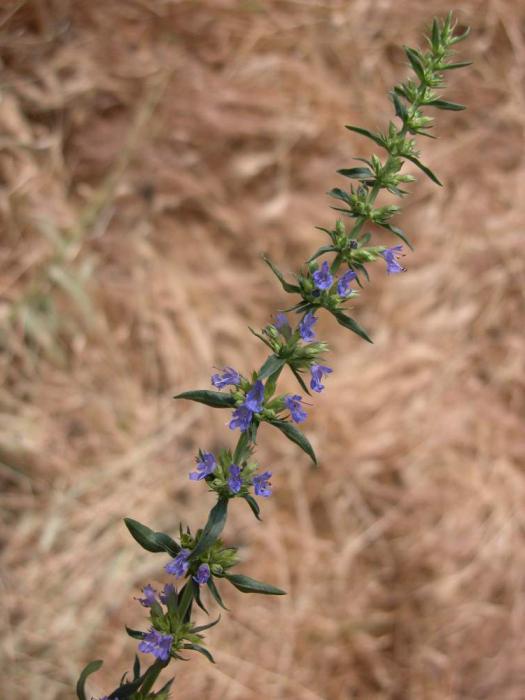

Success secrets
Hyssop is absolutely indifferent to soil fertility, but prefers loose and alkaline ones. Absolutely does not tolerate swampy soil.
It is better to plant a plant in well-lit areas, which are dug up in the fall, compost or phosphorus-potassium fertilizers are applied.
Young Hyssops should be protected from weeds: weed and loosen the soil. Water needs are met by precipitation; irrigation will be required only in case of a very prolonged drought.
Once or twice a season, the bushes are fed with a solution of mullein (1: 5), chicken droppings (1:15) or azofoska.
An overfed plant does not bloom well.
Hyssop tolerates formative pruning well and recovers quickly. The procedure is carried out in spring and autumn, often combined with the collection of medicinal raw materials.
To obtain seeds, it is necessary to cut off the brown inflorescences and ripen them indoors or under a canopy. This method will prevent self-seeding.
Hyssop hibernates without shelter, even in regions with little snowy winters.
Brief description of cultivation
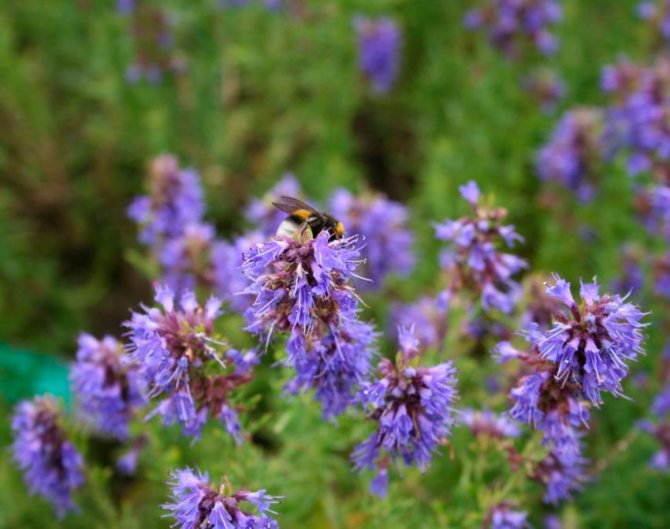

- Bloom... June – October.
- Landing... Sowing seeds in open soil is carried out in April or May, sowing seedlings - from early to mid-March, transplanting seedlings into open soil - from mid to late May.
- Illumination... The site should be well lit.
- Priming... Pre-fertilized calcareous soil should be well-drained and moderately moist.
- Watering... It needs watering only during a prolonged drought, while 1.5 to 2 buckets of water are taken per 1 square meter of the plot.
- Fertilizer... It is necessary to feed only if necessary; for this, a solution of a complex mineral or organic fertilizer is used.
- Pruning... At the same time with the collection of medicinal raw materials.
- Reproduction... Seeds. It reproduces well by self-seeding.
- Harmful insects... Do not settle on the bush.
- Diseases... Rust, rhizoctonia, fusarium wilting or white spot.
- Properties... It is a medicinal plant, which is distinguished by antipyretic, diuretic, laxative, antimicrobial, wound healing, expectorant, antiseptic, bactericidal, analgesic, antihelminthic and stimulating effect.
Hyssop care
- Until the aboveground mass is closed, the plants are systematically loosened.
- Watering is carried out every 2-3 weeks when the topsoil dries up only young plants. In the future, watering is carried out in dry periods. A small amount of moisture is sufficient for plants. They endure drought calmly.
- Young plants are fed, if necessary, once a month with full fertilizer (nitrophos, nitroammophos and others). One of the dressings can be replaced by adding wood ash. Since the root of the hyssop is pivotal, then by the age of 2 - 3 years of age you can switch to a one-time feeding. Moreover, top dressing must be carried out before flowering. In practice, hyssop is fed when necessary or when grown in depleted soils.
Benefit, harm to the body
Knowing about the beneficial properties of culture, it is important to take into account the nuances of the impact on specific categories of people - adults and children, men and women.
For adult men and women - for potency and in gynecology
Women need "blue St. John's wort" during menopause: improves condition during hot flashes, reduces sweating, irritability, normalizes sleep.
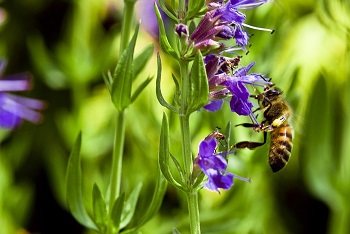

To obtain the effect, 2 teaspoons of medicinal raw materials are brewed with a glass of boiling water, insisted and drunk before meals, 50-70 ml each.
The so-called "women's tea" serves the same purposes., in which, in addition to hyssop, put lemon balm, cuff and hops.
A decoction of hyssop is used to treat erosion (douching)The oil is used to calm the nerves and normalize the menstrual cycle.
Experts note the ability of a plant to affect the reproductive system of the female body, the ability to weaken lactation, if the woman needs to complete breastfeeding of the baby.
For men, this natural remedy is recommended (in combination with therapeutic treatment) for prostatitis, impotence, and diseases of the urinary tract.
If a man has problems with alcohol, the hyssop infusion effectively eliminates the hangover syndrome.
For pregnant and lactating women
This remedy is contraindicated for pregnant and lactating women., since it increases the tone of the uterus and can provoke a miscarriage, reduces the amount of milk produced by the mammary glands.
External use of decoctions is allowed (with the approval of the attending physician) for skin inflammations, wounds, abscesses, in the treatment of eye diseases.
For kids
For children under 3 years old (according to some sources - up to 5) hyssop - prohibited in any dosage form. In the future, it can be taken to treat abrasions, bruises, bruises. Broths are allowed to be taken from a cough, however, the concentration of drugs is reduced by 40-50 percent compared to an adult.
In the old days, the plant was used to relieve a child of bad dreams, night fears. To do this, stuffing the mattress, they added dry leaves to it, and also filled the bag with them and put it under the pillow.
In old age
This natural remedy helps the elderly to cope with the symptoms of angina pectoris, high blood pressure, anemia, rheumatism. It normalizes sleep, relieves fatigue, soothes.
With the help of hyssop traditional medicine advises to solve such a frequent age-related problem as tinnitus... To do this, half a glass of powdered stems and leaves are mixed with the same amount of natural honey. Take one teaspoon three times a day.
Special categories
For diabetics, the pharmaceutical industry offers hyssop syrup. In addition to its extract, the composition includes fructose and stevia, which replace traditional sugar, and water.
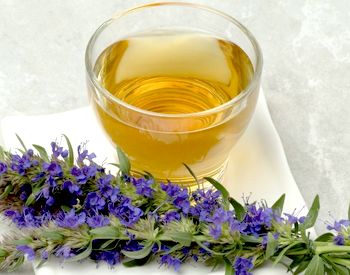

Regular consumption of syrup improves tone, improves metabolic processes, reduces weight. It is useful in the season of colds, as a preventive measure, and also for lowering blood pressure (which is important for diabetics) and strengthening blood vessels.
Recommended in dietetic food, as it makes even "boring" healthy dishes tasty, savory.
An allergic reaction to hyssop occurs infrequently, therefore, for people with individual intolerance to drugs and products, doctors recommend hyssop.
For example, in cosmetology, its oil is used for skin prone to allergic reactions... It improves the complexion, relieves the patient from the small vascular pattern on the skin.
Athletes should only use this natural preparation if recommended by a doctor.
There are cases when a hyssop, used illiterately, brought a person into a state close to affect, and for an athlete, strong nerves are very often a guarantee of his victories.
Composition, calorie content, nutritional value and glycemic index
The calorie content of 100 g of hyssop is 21 kcal... Nutritional value is represented by proteins (almost 4 g), fats (0.6 g), carbohydrates (0.2 g). There is no water in the dried product, just as there is no dietary fiber.
The glycemic index of hyssop is not included in even the most detailed lists: the product is used in such scanty quantities that, whatever this indicator may be, it cannot radically change the characteristics of dishes prepared with it and pose a threat to people who monitor blood sugar levels.
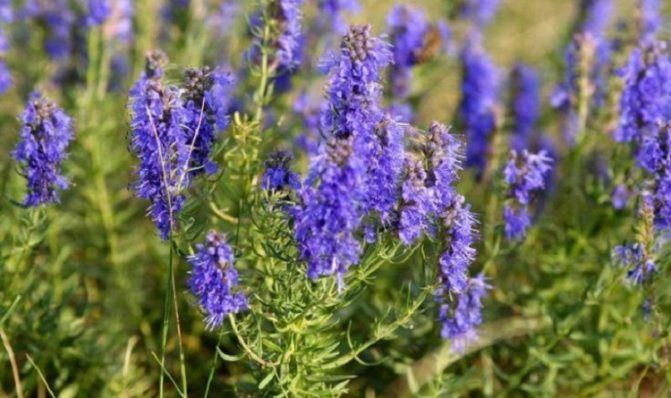

The spices to which the culture belongs (basil, oregano, cinnamon, parsley) have a glycemic index of 5 units.
The chemical composition is presented:
- essential oils (their volume in the total mass is 0.6-2 percent);
- tannins (inhibit the development of pathogenic microorganisms);
- tannins;
- organic acids (among them - coffee, rosemary);
- ascorbic acid;
- flavonoids (natural dyes);
- aldehydes (they are responsible for aroma);
- alcohols;
- minerals (they are represented by potassium and magnesium, calcium, aluminum, silicon).
The chemical composition changes depending on the stage of growth culture.
The richest, most useful "bouquet" is distinguished by a flowering plant. That is why the procurement of medicinal raw materials is timed to the peak of flowering.
Photo hyssop herb
Please repost
0
2
Tincture
For flatulence and chronic colitis, drugs from a plant such as hyssop are used. We already know what it is. The tincture is used externally as a compress accelerating wound healing.
To prepare it, 100 g of plant herb must be poured with a liter of dry white wine. Then the tincture is removed for 3 weeks in a cool and dark place, while the product must be shaken regularly. The tincture is filtered before use. It is consumed three times a day for a teaspoon.
Landing in open ground
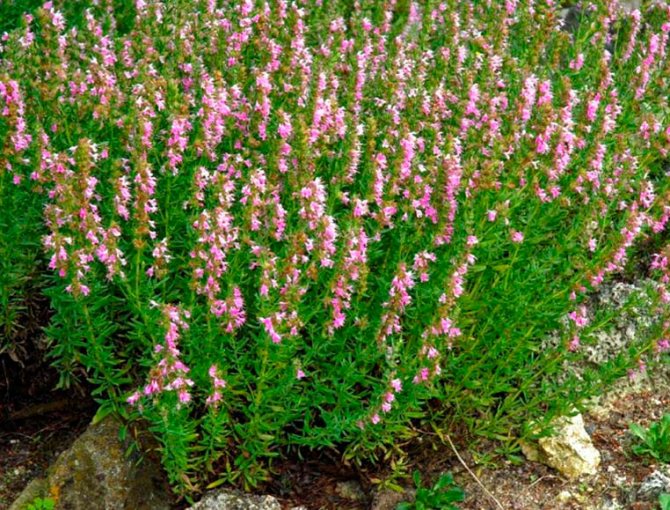

Suitable soil
In the same place without transplanting, hyssop can be grown for about 10 years, in this regard, the choice of a suitable site must be taken with full responsibility. Such a plant needs a lot of sunlight, as well as a well-drained, moderately moist calcareous soil. Potassium salt, manure and a small amount of superphosphate must be added to it in the autumn during deep digging. Areas that are swampy or saline are not suitable for growing such a crop, as are those in which groundwater is very close to the soil surface.
Landing times and rules
Planting in open soil is carried out when the plants are 45 to 60 days old from mid to late May, while return spring frosts should be left behind. Seedlings are planted in loose soil, while maintaining the distance between the plants from 8 to 10 centimeters, and the distance between the rows should be from 25 to 30 centimeters. The planted plants need watering.
Potential hazard
In what cases do contraindications work? There are not so many of them:
- individual intolerance to "blue St. John's wort";
- epilepsy;
- kidney disease;
- pregnancy and breastfeeding.
For those for whom the plant is not contraindicated, its overdose is dangerous due to the threat of spasms.
If a person is taking medication, it must be borne in mind that "Blue St. John's wort" enhances the effect of drugs that lower blood sugar, cholesterol levels, prolongs the effect of antiviral and anti-inflammatory drugs.
Hyssop care requirements
Hyssop can grow anywhere in the garden, but it needs enough light. In the shade, the content of essential oils sharply decreases in it.
Hyssop is a very interesting plant to care for.
- The culture is not affected by diseases and pests, but it can get sick from excessive watering and feeding.
- Needs weeding at a young age and pruning flowering shoots.
- With regular pruning, the plant bushes well, throws out new candles with buds.
- The cut flowering twigs are dried and used in teas and broths.
- For the winter, the bush is cut off, leaving high (15-20 cm) hemp above the ground.
- Before the bushes close, the soil is mulched after watering.
Growing area
In its homeland - in the Mediterranean countries, hyssop grows in the wild on dry rocky soils of slopes and hills. It is widely grown as an ornamental plant due to its bright and long flowering. The conditions of Central Asia, Southern Ukraine, the European part of Russia and the Caucasus Mountains are suitable for cultivation. In places of cultivation, it is able to turn into a wild-growing form, the medicinal properties of which are gradually decreasing, therefore, plantation sites are regularly changed every five years.
Infusion
The infusion of the hyssop plant stimulates the secretion of our digestive glands, in addition, it increases appetite and reduces fermentation processes in the intestines. It is used externally for diseases of the pharynx and oral cavity for rinsing, in addition, with conjunctivitis, the eyes are washed with it. It has been proven that it helps to get rid of the herpes virus, therefore, hyssop is used externally for exacerbation of this disease.
20 g of chopped and dry herbs should be placed in a thermos, then pour a liter of hot water, leave for 25 minutes. The infusion is taken half a glass 3 times a day.
Side effects
You can use other recipes that are most likely to benefit you.But you should know that this very valuable medicinal plant also has side properties and contraindications.
- Hyssop medicinal has a stimulating effect on the heart muscle, it increases blood pressure with simultaneous vasoconstriction, so it cannot be used for hypertensive patients.
- Another very significant drawback is that hyssop preparations can cause constipation, so they must be used strictly in dosage.
- Hyssop is often used in incense and incense. There are cases when inhalation of the smoke of such mixtures causes allergies and even spasms, so people with a predisposition to allergens should refrain from such methods.
What is useful for health, organs and systems
Both fresh and dried plant have health benefits - all parts of it, except for the roots.


If they want to heal the soul with hyssop (its magical properties have long been known), take only dry twigs and leaves - devoid of moisture, they supposedly acquire a strong energy.
The rich chemical composition of hyssop is used for:
- support the immune system;
- improving brain function;
- concentration of attention;
- improving memory;
- strengthening nerves, protecting against stress;
- enhancing physical activity and performance;
- normalization of hormone levels;
- slowing down the aging of the body;
- strengthening of blood vessels;
- fast healing of burns, wounds;
- elimination of carcinogens.
Oleanolic Acid Helps Relieve Arterial Spasms, participates in the normalization of the heart rate, can enhance the effect of antibiotics taken in the treatment of kidney disease.
Ursolic acid protects against kidney stones, reduces blood pressure and the risk of developing tumors, very beneficial for skin damaged by too much sun exposure.
Glycosides are important for the intestinal mucosa: they have a strong antimicrobial, disinfectant effect.
Resins are a powerful antioxidant, and vitamin C is involved in hematopoiesis, supports the normal functioning of the endocrine glands.


